Peter Cawdron's Blog, page 10
May 17, 2016
Born Free?
Contrary to popular misconceptions and a best selling book by Sam Harris, you have freewill.
Over the past decade, there’s been considerable debate on the nature of consciousness and freewill. Leading thinkers, such as Sam Harris, have somewhat predictably advocated for a purely materialistic view of freewill because of the religious/mystical implications of concepts like “spirit” and the “soul,” and with good, logical reasons. Whatever the soul is, it clearly resides in the brain. If the brain is a material object, then so is the soul, and freewill is simply the exercise of a complex (and arguably predictable) physical system.
Freewill, in this scenario, is an illusion, and our actions are predetermined by a complex series of physical constraints—genetics, exposure to parents, friends, even harsh/kind physical environments. The thinking is that if could these be exactly replicated down to the last possible detail, then so could you.
At first, you might be tempted to think, “That’s ridiculous, of course I have free will. I am me.” But stop and consider this: if time could be rewound to the point of your birth and replayed without your knowledge, would you be the same person you are today? Would you make the same choices? At each point in time, are you free to make a new decision, or are you channeled and directed into making exactly the same decisions by your genetics, your circumstances and those around you?
Extend this to its natural conclusion and you end up with statements like this from The Atlantic magazine:
…the brain [is a] physical system like any other, and [this] suggests that we no more will it to operate in a particular way than we will our heart to beat. The contemporary scientific image of human behavior is one of neurons firing, causing other neurons to fire, causing our thoughts and deeds, in an unbroken chain that stretches back to our birth and beyond. In principle, we are therefore completely predictable.
It’s not difficult to see the debate around freewill as the atheist’s verision of the predestined theology of Calvin. The wonderful irony in the debate over freewill is only those with freewill can debate whether they have freewill.
By the way, we have rewound the evolutionary clock and replayed it…and it produces slightly different results! Professor Richard Lenski is in the midst of conducting a multi-decade experiment on the evolution of E. coli and every 500 generations he freezes a clonal sample, effectively giving him a living fossil, capable of being thawed and revived. As he’s observed different traits at upwards of 30,000 generations, he’s been able to go back and thaw out a particular cell line and replay the evolution that led to the formation of that trait. The result? Not as predictable as you’d think. Sometimes the trait reemerges, but not at the same point, sometimes it doesn’t. And remember, this is conducted under strict laboratory conditions where every possible variable is meticulously controlled.
Replaying biological processes isn’t nearly as neat and as predictable as we think. Life is not a binary program in a computer. If replaying the growth of something as simple as bacterial clones kept in controlled laboratory conditions leads to variation, what about replaying your life choices? Would you really be compelled to make the same choices over and over again, or would you be free to choose each time and possibly come up with different selections? Chocolate ice cream instead of vanilla?
As you can see, the debate over freewill is not nearly as clear cut as it at first seems.
How can I be confident that both you, and I, and Sam Harris have freewill? Strictly speaking, I can’t, but I can point out the folly of trying to make such a dogmatic claim without evidence.
For me, this debate is grossly premature. We have such a poor understanding of how the brain works that it is conceit to make such confident claims without clear evidence.
In many ways, the argument is akin to those who categorically state there’s no life in outer space. The evidence just isn’t there to draw any conclusions either way. In regards to SETI, the advent of instruments like the James Webb Space Telescope give us a very good chance of detecting life beyond our star, but at the moment, we’re not even sure if there’s life elsewhere in our own solar system. We can’t categorically say whether there is or there isn’t. There may well be subsurface microbes on Mars. Certainly, there’s unexplained methane production on this geologically inactive world that leaves us scratching our heads. What about the low-level hydrogen anomaly on Titan? Or Europa? Or Enceladus? The point is, we need to explore to find the answer, and not make categorical statements one way or the other until the evidence is in.
We simply don’t have enough evidence to make a call in regards to freewill. The evidence we do have suggests freewill is real. One study exposed participants to optimistic and pessimistic views about freewill and then observed freewill choices being biased by that exposure, with those that thought there was no freewill being more likely to use their freewill to cheat!
The human brain has an estimated 100 billion neurons, with upwards of a trillion connections running between them. As astonishing as it may seem for something that’s roughly the size of a football, the brain is the single most complex structure ever observed anywhere in the universe.
How close are we to being able to map the human brain? We’re not even close to starting. As of 2016, the European Union has spent over a billion dollars on the Human Brain Project (which started in 2005 as the Blue Brain Project) and yet scientists from around the world are calling for it to be scrapped as it is grossly premature given our current technology.
How can we draw conclusions about the inner workings of an organ we don’t understand?
Ah, but is it simply a case of processing power? Is it simply that we’re not ready yet, but perhaps could map the brain and understand its deterministic patterns in 2020 or 2030? No. I suspect there is no underlying deterministic model for one simple reason: quantum mechanics.
Einstein was uneasy about the concept of quantum mechanics, the idea that at a subatomic level, energy is comprised of packets, as it introduces a level of uncertainty that isn’t simply related to our measuring instruments but is part of the very nature and fabric of reality. Quantum mechanics effectively negates the Newtonian concept of a clockwork universe which can be rewound and replayed verbatim, dismissing the notion of hard determinism.
One exciting field of scientific research I’m following with keen interest is quantum biology—the idea that evolution has developed biological processes that exploit quantum mechanics.
Birds and insects use a concept known as magneto-reception to navigate long distances, something that appears to rely on quantum entanglement at a subatomic level. Photosynthesis is remarkably efficient, so much so it seems to derive at least some of that efficiency from quantum tunneling. While even our sense of smell, and that of dogs, may be so remarkably sensitive due to quantum factors.
Quantum biology is an emerging field, and the science isn’t settled, but it appears to answer a number of questions about the animal and plant kingdom and may well explain natural physical phenomena like consciousness and freewill. The recent discovery of quantum vibrations in “microtubules” inside brain neurons is reviving a controversial theory that consciousness may in part be the result of quantum effects—something that would support the concept of freewill as it suggests that our conscious awareness is an ongoing, vibrant, non-deterministic process.
But as I noted above, the evidence is not in yet for either camp in this debate. There is no reason to jump on the deterministic bandwagon. But, hey, you’re free to make up your own mind
Born Free
Contrary to popular misconceptions and a best selling book by Sam Harris, you have freewill.
Over the past decade, there’s been considerable debate on the nature of consciousness and freewill. Leading thinkers, such as Sam Harris, have somewhat predictably advocated for a purely materialistic view of freewill because of the religious/mystical implications of concepts like “spirit” and the “soul,” and with good, logical reasons. Whatever the soul is, it clearly resides in the brain. If the brain is a material object, then so is the soul, and freewill is simply the exercise of a complex (and arguably predictable) physical system.
Freewill, in this scenario, is an illusion, and our actions are predetermined by a complex series of physical constraints—genetics, exposure to parents, friends, even harsh/kind physical environments. The thinking is that if could these be exactly replicated down to the last possible detail, then so could you.
At first, you might be tempted to think, “That’s ridiculous, of course I have free will. I am me.” But stop and consider this: if time could be rewound to the point of your birth and replayed without your knowledge, would you be the same person you are today? Would you make the same choices? At each point in time, are you free to make a new decision, or are you channeled and directed into making exactly the same decisions by your genetics, your circumstances and those around you?
Extend this to its natural conclusion and you end up with statements like this from The Atlantic magazine:
…the brain [is a] physical system like any other, and [this] suggests that we no more will it to operate in a particular way than we will our heart to beat. The contemporary scientific image of human behavior is one of neurons firing, causing other neurons to fire, causing our thoughts and deeds, in an unbroken chain that stretches back to our birth and beyond. In principle, we are therefore completely predictable.
It’s not difficult to see the debate around freewill as the atheist’s verision of the predestined theology of Calvin.
The wonderful irony in the debate over freewill is only those with freewill can debate whether they have freewill.
How can I be confident that both you, and I, and Sam Harris have freewill? Strictly speaking, I can’t, but I can point out the folly of trying to make such a dogmatic claim without evidence.
For me, this debate is grossly premature. We have such a poor understanding of how the brain works that it is conceit to make such confident claims in the face of (largely subjective) evidence to the contrary.
In many ways, the argument is akin to those who categorically state there’s no life in outer space. The evidence just isn’t there to draw any conclusions either way. In regards to SETI, the advent of instruments like the James Webb Space Telescope give us a very good chance of detecting life beyond our star, but at the moment, we’re not even sure if there’s life elsewhere in our own solar system. We can’t categorically say whether there is or there isn’t. There may well be subsurface microbes on Mars. Certainly, there’s unexplained methane production on this geologically inactive world that leaves us scratching our heads. What about the low-level hydrogen anomaly on Titan? Or Europa? Or Enceladus? The point is, we need to explore to find the answer, and not make categorical statements one way or the other until the evidence is in.
We simply don’t have enough evidence to make a call in regards to freewill. The evidence we do have suggests freewill is real. One study exposed participants to optimistic and pessimistic views about freewill and then observed freewill choices being biased by that exposure, with those that thought there was no freewill being more likely to use their freewill to cheat!
The human brain has an estimated 100 billion neurons, with upwards of a trillion connections running between them. As astonishing as it may seem for something that’s roughly the size of a football, the brain is the single most complex structure ever observed anywhere in the universe.
How close are we to being able to map the human brain? We’re not even close to starting. As of 2016, the European Union has spent over a billion dollars on the Human Brain Project (which started in 2005 as the Blue Brain Project) and yet scientists from around the world are calling for it to be scrapped as it is grossly premature given our current technology.
How can we draw conclusions about the inner workings of an organ we don’t understand?
Ah, but is it simply a case of processing power? Is it simply that we’re not ready yet, but perhaps could map the brain and understand its deterministic patterns in 2020 or 2030? No. I suspect there is no underlying deterministic model for one simple reason: quantum mechanics.
Einstein was uneasy about the concept of quantum mechanics, the idea that at a subatomic level, energy is comprised of packets, as it introduces a level of uncertainty that isn’t simply related to our measuring instruments but is part of the very nature and fabric of reality. Quantum mechanics effectively negates the Newtonian concept of a clockwork universe which can be rewound and replayed verbatim, dismissing the notion of hard determinism.
One exciting field of scientific research I’m following with keen interest is quantum biology—the idea that evolution has developed biological processes that exploit quantum mechanics.
Birds and insects use a concept known as magneto-reception to navigate long distances, something that appears to rely on quantum entanglement at a subatomic level. Photosynthesis is remarkably efficient, so much so it seems to derive at least some of that efficiency from quantum tunneling. While even our sense of smell, and that of dogs, may be so remarkably sensitive due to quantum factors.
Quantum biology is an emerging field, and the science isn’t settled, but it appears to answer a number of questions about the animal and plant kingdom and may well explain natural physical phenomena like consciousness and freewill. The recent discovery of quantum vibrations in “microtubules” inside brain neurons is reviving a controversial theory that consciousness may in part be the result of quantum effects—something that would support the concept of freewill as it suggests that our conscious awareness is an ongoing, vibrant, non-deterministic process.
But as I noted above, the evidence is not in yet for either camp in this debate. There is no reason to jump on the deterministic bandwagon. But, hey, you’re free to make up your own mind on this ;)


May 4, 2016
Would Mars attack?
Who doesn’t love a good alien invasion story? UFOs buzzing around. Lasers firing. Buildings exploding in flames. What’s not to love?
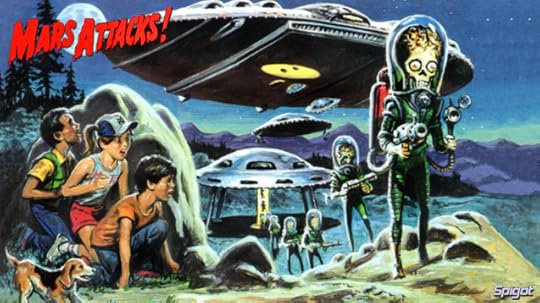
Picture credit: Mars Attacks
But why would Martians ever attack us?
If Hollywood is to be believed, it’s because aliens want our water, or they want to enslave us, or they want to steal our minerals. In reality, none of these are valid reasons.
We like to think we have a lot of water. After all, 70% of the Earth’s surface is covered in water. And yet there’s more water on both Europa and Titan, two of the moons of Jupiter, than there is on all of Earth. Any thirsty alien is going to stop by there for a drink. It might surprise you to learn that even dry, dusty Mars has roughly half as much water as Earth locked up in icecaps and subsurface aquifers. And there’s no pesky locals to worry about.

Picture credit: Sploid Comparison of liquid water
As for minerals, mining asteroids is far more productive.
ICT outsourcing giant Accenture estimates that even with the cost of launching into space (something our intrepid aliens would have already accomplished), the cost of mining asteroids is coming astonishingly close to mining minerals on Earth, and the cost is only going to plummet further as our space-faring technology improves.

Picture credit: NASA estimates Eros has 20 billion tons of gold (20,000X everything produced on Earth each year)
Ah, but what about enslaving us? Nope. Not economically viable. The cost associated with navigating across the vast oceans of space to reach Earth must surely outweigh any manual labor benefits gained on arrival. Once, slavery sustained economic progress on Earth, but even without the moral impetus to treat others fairly, that model hasn’t been economically viable for over a hundred and fifty years. And with the advent of robotics, even purpose-built factories with low cost workers are becoming out-moded. I doubt ET would be motivated by such archaic notions as enslaving people.
So why would aliens ever visit Earth?
Well, there is one reason, and one reason alone. Earth contains something far more precious and valuable than the finest gold or the rarest of gems like the Hope diamond—Life.

The Great Andromeda Galaxy, M31, is one of the most distant objects that can be seen with the unaided eye at 2.5 million light-years from Earth—picture credit Tom Matheson
From staring out into space over the past few centuries, we’ve learned the universe is an astonishingly vast and lonely place. The most precious substance in the universe is life, which is somewhat ironic given how abundant life is on Earth. Ah…. so they would come to steal our life forms? Nope. That’s not it either. One of the wonderful characteristics of life is that it reproduces, effectively duplicating itself. There’s no need to steal anything. Just a few bacteria cells are enough to form untold colonies. Just a few seeds can produce a forest given time.
Aliens would never attack Earth because there’s simply no militaristic reason that justifies the immense cost in getting here, but I’m sure they’d love to visit, because life is so rare as to demand investigation.
One of the astonishing things about evolution and the process of natural selection is that life winnows and refines chemicals with remarkable efficiency. Biology is astonishingly effective at finding novel chemical solutions to problems. And this is something life-science medical research companies like EcoBiotics have realized, turning their microscopes to the rainforest and tropical reefs in the search for cancer treatments. There are at least 10^60 (that’s 1 with 60 zeroes after it) different chemical structures that can be formed using carbon, but the vast majority of these have no use in biology. Numbers like these are stupidly big, but evolution has had billions of years to experiment on various combinations of molecules to find effective solutions to common problems.
Although alien life would differ vastly from Earth-life at a macroscopic level, shrink down to the level of molecules and there are probably going to be an astonishing number of parallels simply because alien life has to work with the same set of 115 known elements. Everything we see around us is constructed from a “lego set” with barely more than a hundred different types of lego brick, when our kids have access to over four thousand.

Picture credit: Lego. There are 4200 different types of lego brick
So from ET’s perspective, Earth would be a treasure chest of novel chemical solutions. Earth would be something to be explored, not only from the novelty factor or out of scientific interest, but because there might be unique applications that are beneficial to them.
I explore this concept in my novels Xenophobia and Welcome to the Occupied States of America, looking at how unique life is on this remarkable planet.
Scientists estimate there are a trillion different species on Earth, that’s 1,000,000,000,000 different forms of life!! There are more species on Earth than there are stars in the Milky Way, which is astonishing. Earth really is an oasis in the middle of a celestial desert. If aliens ever do visit Earth, the one thing that will surprise them is how we take life for granted, and how we’ve driven species to extinction in pursuit of money. Perhaps the greatest thing First Contact will accomplish is an appreciation of just how wonderful our planet really is.
If you’re a fan of good science fiction, be sure to check out Welcome to the Occupied States of America.


April 1, 2016
The case for life on Mars
I’m highly skeptical about the prospect of life on Mars.
Mars has no global magnetic field to protect any fragile, budding life.
Whereas our magnetic field extends some 20 times the radius of Earth, Mars has little to no magnetic field, with just small, localized pockets. Not only does this mean the surface of the planet is bombarded with solar and cosmic radiation, but the solar wind strips away light elements in the atmosphere, leaving predominantly heavy gases like carbon dioxide.
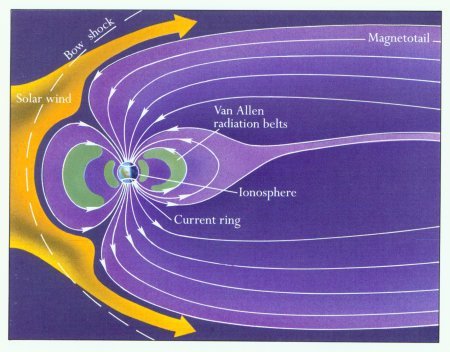
Earth has a massive, global magnetic field. Picture credit: Illinois University
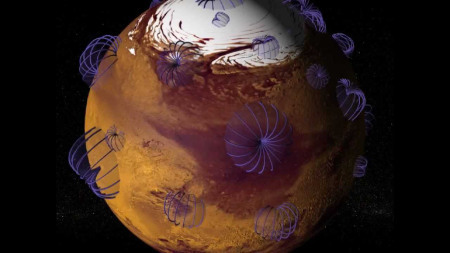
On Mars, magentic fields are small & localized. Picture credit: NASA
In addition to this, Mars is considerably smaller than Earth.
Mars is closer in size to our Moon than it is to Earth itself, having roughly 1/3 of the gravity. This means it’s escape velocity is much lower, which also allows the atmosphere to bleed off into space, leaving the density of the atmosphere roughly a thousand times lower than ours at sea-level.

Picture credit: NASA
One day, no doubt, we’ll settle Mars, but it will take a gargantuan effort as Mars is not in any way conducive to sustaining human life. Mars isn’t the pick of the bunch, it’s the least lethal of a motley crew.
So why am I writing a blog post about the case for life on Mars? Because there’s something rather startling about the martian atmosphere that may be hinting at the possibility of life.
For decades, astronomers looking for life in outer space have spoken of The Goldilocks Zone, the habitable area around a star where life could arise on an Earth-like planet—an orbit where it is not too hot, not too cold.

Picture credit: Keck Observatory
Now, though, there’s a realization that the Goldilocks Zone is an oversimplification. Jupiter and Saturn, for example, are well outside the Goldilocks Zone, and yet there’s good reason to think their moons may harbor life.
Which of these planets looks hospitable?
Which one do you think is most likely to support life?

Picture credit: NPR
The answer is—all of them.
This image represents what Earth would have looked like at various points in the 3.8 billion years during which life has thrived.
Although Earth is in the Goldilocks Zone, it’s spent time bouncing between extremes, from sweltering temperatures to freezing cold ranges not unlike those found on Mars. Temperatures plummeted to -58F during the Snowball age. Even at the equator, the temperature is estimated to have been at least -4F, and yet life on Earth survived. On the hot side of the equation, there’s good reason to consider that life itself may have arisen on Earth when temperatures were reaching upwards of 300F.
One common retort of creationists when comparing Earth to other planets is, “Look at how perfectly suited Earth is to life. Look at how moderate it is compared to the hellish conditions on Venus, or the frozen wastelands of Mars.” But this fails to consider Earth’s dynamic history. Earth is perfectly suited to life, but that’s not by coincidence or providence. Life has transformed Earth. Microbes have taken an inhospitable planet with a choking toxic atmosphere and transformed it into the oasis we enjoy today.
Life is astonishing. Natural Selection has allowed life to exploit finely balanced chemical pathways. The free energy involved in supporting life tends to be around 3 kcal/mol, which is low, right on the borderline of what’s useful. Chemicals react. Chemicals react a lot. And when chemicals react, they produce reactants rather than being funneled into useful products, so life has evolved to avoid the startling reactions you’re used to in high school chemistry, instead it tip toes on the edge of a chemical cliff, at energies less than those required to break a hydrogen bond. That might sound overly complex (and a diversion from the topic) but it’s important to understand, as life carves out a niche for itself. Every day, trillions upon trillions of these tiny mini-reactions keep us alive.
The point is… (a) life exploits chemistry to sustain itself and (b) life transforms its environment to support itself.
So what about Mars?
Ah… this is where it gets interesting…
As I’ve documented in another post, Mars has methane, something that is surprising as methane is easily broken down by ultraviolet light, so for us to detect methane in the atmosphere, it must be replenished by some process. As best we understand it, methane is a byproduct of either volcanic activity or life. As there are no active volcanoes or flatulent cows on Mars, it does raise the question, where is the methane coming from? The odds are that it’s arising from some obscure tectonic process. ESA’s ExoMars satellite will arrive in orbit around Mars in October of 2016 to investigate this further.
And this raises another interesting point. When we look at celestial objects, we see them largely unchanged after billions of years. The Moon has craters and geological formations that span four billion years. Unless a planet has an active atmosphere and something like plate tectonics, it tends to be astonishingly stable over long periods of time.
Do you believe in coincidences? I don’t. And so that Mars is producing methane and has an atmosphere that is fine tuned to almost precisely the triple-point of water, seems to be a smoking gun for the possibility of active, subsurface microbial life.
Water can exist in three states—as a solid (ice), liquid (water), gas (vapor). The extremes we observe in space mean that often water has no choice. The environment on Venus, for example, is so hot and highly pressurized, water exists only as vapor. On Pluto, the temperatures and pressures are so low that water is locked away as ice. But on Mars, and on a few of the moons of Jupiter and Saturn, there are places where liquid water can be found. Given that this only occurs in an extremely narrow band of temperature and pressure, this is quite astonishing.

Picture credit: MIT
Remember those trillions of finely tuned moderate chemical interactions with free energy around 3 kcal/mol that keep you alive? They all need liquid water as a medium.
It is significant that the atmosphere of Mars is finely balanced so that it hovers around the triple point of water, the point where water can exist in all three states simultaneously (as ice, water and vapor). Coincidence? Or is this an example of what we’ve seen on Earth, where microbial life fights against geological and astronomical odds to sustain itself by transforming and moderating its own environment?

Subsurface water leaking on Mars. Picture credit: NASA
Is it really just a coincidence that the martian atmosphere has settled on a point of equilibrium around the triple-point of water? And that this has been sustained for hundreds of millions, perhaps billions of years?
Life didn’t always dominate Earth. There were points in time where life was almost completely wiped out, like during the snowball Earth phase, but life kept a toehold and fought back.
Is that what we’re observing on Mars? The last refuge of martian microbes fighting to sustain the equilibrium/habitability of their planet? It’s an interesting idea, and one we’ll undoubtedly learn more about as organisations like NASA and ESA continue to explore the red planet.
____________________________
At this point, WordPress slips in some ads, so I thought I would squeeze one in as well. Here’s my latest novel, Starship Mine.


March 5, 2016
Science fiction & science
Recently, I was approached by a university student developing a thesis on the inventions featured in sci-fi films and the likelihood of their actualization. He had some great questions I thought would make for an interesting blog post.
Do you think people feel let down by the lack of real world inventions inspired by modern or even classic works of science fiction?
Oh, no. The prescience of science fiction and the pace of innovation we’re seeing in science is astonishing. If anything, we have unrealistic expectations. We’ve come to see spectacular advances as commonplace, failing to appreciate the astonishing scientific advances required to make them possible.
In 1865, Jules Verne captured the imagination of the public with his novel From Earth to the Moon. Invariably, his solution to the seemingly insurmountable technical problems of traveling to the Moon were wide of the mark, but the concept was brilliant. Verne understood there was a need to reach escape velocity, but the only means he knew of potentially accomplishing this was with cannons. He knew such a launch would be fatal, so he cleverly introduced the idea of wooden baffles separated by water, which would sequentially break to reduce the trauma of sudden acceleration. For it’s time, it was an ingenious (but impractical) idea, but science fiction isn’t about posing actual engineering solutions, rather it’s to inspire out-of-the-box thinking.

Water filled baffles below the floor were to make the launch survivable
In 1903, less than 40 years later, the Wright Brothers flew a mere 120 feet down a sandy beach. Just 12 seconds of flight time, and yet, by the 1960s, planes were crisscrossing the planet, and both the Russians and the Americans were sending probes to the Moon. Barely a century after Verne published his story, Neil Armstrong took one small step on the lunar surface. Cannons played no part in the Apollo program, and yet Verne’s vision inspired lunar exploration.
In the same way, Star Trek used handheld communicators and tricorders for making non-invasive medical diagnosis. Half a century later, we think nothing of cell phones, PET and MRI scans. Our devices may not be as small, but miniaturization is just a matter of time.
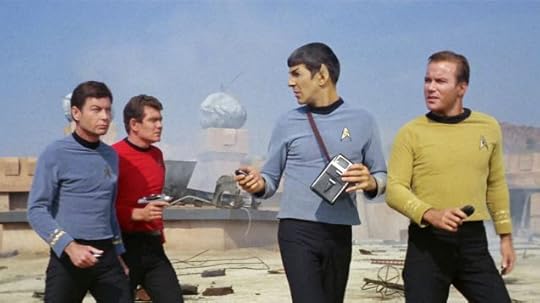
Uh, oh… unknown actor in red shirt. Thankfully, Spock’s got a tricorder
Science is far more radical than science fiction dares imagine. Take the PET scanner as an example. Few people realize what a PET scan actually does—positron emission tomography. Ever heard of a positron before? Not an electron, a positron? Positrons are antimatter (another buzz word bandied about by Star Trek). Low doses of radioactive material allow us to see inside organs and observe the chemical functions taking place within cells, detecting tumor growth, or abnormal organ activity. It’s astonishing technology. In Star Trek, it was an idea. Today, it’s reality.

electron/positron pair in a cloud chamber
Don’t look to science fiction for scientific accuracy—look for ideas that might become reality.
Our best chance of detecting intelligent extraterrestrials comes from the possibility they may use Dyson Spheres, massive structures designed to harness solar energy. Indeed, there’s conjecture the star KIC-8462852 may harbor such a structure.
Although this concept was popularize by physicist Freeman Dyson, the concept has it’s roots in the speculative science fiction of the early 20th century, and authors such as Edgar Rice Burroughs, and Olaf Stapledon‘s Star Maker.
Science fiction shouldn’t be confused with science. The two are entirely different fields, and yet the speculation of one can lead to advances in the other.
Do you think that we as a species are making scientific progress at a rate we can collectively be pleased by?
Our lives are so astonishingly short it’s easy to lose sight of how rapidly we are advancing as a species. Barely a century ago, the Wright Brothers flew 20ft above the ground, today, tens of thousands of people are in the air at any one point in time, soaring 30,000ft above the planet. The Wright Brother’s accomplishment wasn’t that spectacular, but it heralded a technological breakthrough that would change the world.
Mary Shelley’s Frankenstein is seen as a horror story, but it was a progressive look at the prospect of organ and limb transplants a hundred and fifty years before medical science made the concept possible. In the novel, Dr. Frankenstein is repulsed by the monster he created, but the central conceit of the story is that the “monster” wants to be understood—to be human. Far from the Hollywood depictions of villagers with pitchforks, Shelley’s Frankenstein raises ethical concerns rather than mindless violence. Now days, we’ve answered those concerns, and the transplant of lungs, hearts, kidneys, livers, etc is commonplace.
Homo sapiens have existed as a distinct species for at least 200,000 years, probably longer. The Homo genus from which we descend is at least 2,000,000 years old. For 99.9% of our existence, we have been plagued by disease. Bacteria and viruses have devastated our population with ruthless efficiency, but no more. The advances of just the past few centuries have seen the introduction of hygiene, vaccines and antibiotics that have allowed us to defy the cruelty of nature.
With all that has been discovered in the past hundred years, from relativity to quantum mechanics, from a detailed understanding of evolution to the exploration of the planets, we as a species are on the cusp of a new age. The only impediment is us ourselves. Can we tackle climate change? Can we protect the astonishing biodiversity we’ve inherited? Can we resolve the cultural and religious differences that drive us to war?
Do you think we are progressing? And in which field would you like to see more development (e.g. travel or medicine)?
A cure for cancer would be nice, but I’d settle for treatments that make malignant cancer a chronic rather than a terminal illness so we don’t lose brilliant minds like Carl Sagan so soon.

Carl Sagan with the Mars Viking probe
As much as I’d love to see footprints on Mars, I think we need to be judicious in how we use our limited resources. Lots of people lament that we’ve never been back to the Moon, but they lose sight of what we have done instead, with the astonishing insights provided by Pioneer, Voyager, Viking, Hubble, Cassini, the rovers on Mars, and dozens of other scientific satellites.
I’ll happily pass on Buck Rogers for good science being done in space. We, as a species, stand to gain much more from scientific advancement than joyrides to satisfy patriotic fever.

Saturn as viewed by Cassini
What do you think is the biggest hindrance when it comes to our development (both scientific and social)?
We have progressed so fast in the past century, there’s been an inevitable backlash, particularly in recent years with the rise of anti-intellectualism. Vaccines have become the target of suspicion. People still cling to the creation myths of old. Conspiracy theories often hold more credence than reality. Few people realize how science pervades every aspect of our lives, from the way food is packaged and stored, to being able to watch live sports on television. Vast sections of society repudiate the notion of climate change, but they fail to see that the same scientific method that gave them iPhones and laptops is warning them about our impact on the environment.
We need to stop seeing science as magic performed on stage, and realize it’s the foundation upon which modern society is built. If we don’t understand it, we should make an effort to learn more. That doesn’t mean everyone needs to be a scientist, but everyone should understand the scientific method as, without it, most of us would be dead, having been killed off by some hideous disease in childhood.
As a science fiction writer, I make science the hero, and try to get readers to see science in a positive light.

The best advice I can give anyone in life is: stay curious, always be willing to learn.


December 11, 2015
My Top 10 (Actually 12) Favorite Short Stories of 2015
Author Will Swardstrom shares his top ten (or so) short stories from 2016
2015 is almost up, and you know what that means…
That’s right — excessive weight gain around the holidays!
Also Top 10 Lists!!
Last year I loved making my Top 10 books of the year (which ended up being around 17 or something), but this year I’m going to break down my lists into smaller categories. One of those will be the Top 10 (Actually 12) Short Stories I read in 2015.
Obviously not comprehensive, and not all were written in the past year, but all made a big impression on me. I’m terrible at telling you exactly which was THE BEST, so I’m just going to give them to you in alphabetical order by the author’s last name. Fair warning — many of them are in the Future Chronicles anthologies since I’ve read each of them this year making them a significant reading source for me each time one…
View original post 1,508 more words


December 9, 2015
Earth
Earth is an astonishing planet for numerous reasons, but perhaps the most remarkable fact is that life didn’t arise on this wonderfully moderate, temperate planet. Instead, the reverse is true, life arose in spite of hellish conditions. Life transformed this planet into an oasis.
Here are some awesome facts about Earth.



October 28, 2015
Cassini duck-dive
Cassini just dove toward Enceladus, reaching down to 30km. On Earth, we’d call this re-entry as it would dip into the stratosphere. As a point of comparison, 747’s routinely fly at 12-14km above Earth, while Mt Everest reaches up to almost 9km above sea-level.
There’s going to be some awesome imagery and some great learning coming in over the next few days.

Here’s an infographic on Enceladus produced by NASA


October 23, 2015
#31ZombieAuthors – Day 23 Interview – Peter Cawdron – Outsmarting Zombies
What are the two most important considerations in the zombie apocalypse?
Read this interview to find out.
 Originally posted on Bookshelf Battle:
Originally posted on Bookshelf Battle:
FIND THIS ZOMBIE AUTHOR ON:
My guest today is Peter Cawdron, who comes from the land down under. I don’t have to pay the Men At Work a royalty for saying that because Peter is an honest to God Australian zombie enthusiast.
Peter’s the author of the Z is for Zombie series of books which include What We Left Behind and All Our Tomorrows. These books tell the story of teenager Hazel, who in the midst of a zombie apocalypse, searches for Steve, David, and Jane, the only people who ever understood her.
An avid fan of such classic science fiction writers as Philip K. Dick, Arthur C. Clarke and Michael Crichton, Peter is also a prolific science fiction author in his own right.
I wonder if there’s an extra charge to call Australia? Aw screw it, the bill…
View original 1,200 more words


September 2, 2015
Meet You
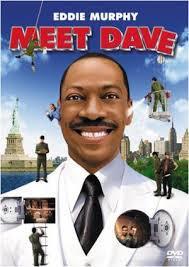
“Meet Dave” is a somewhat forgettable comedy about miniature aliens landing on Earth in a spaceship replicating a human body. It’s a popcorn flick with a bit of humor and a corny love story.
Dave is controlled by tiny people living inside him who have to work together to coordinate his responses in life. As crazy as this sounds, it’s not that far removed from reality.
We intuitively see our lives at a superficial level. I am me. You are you. Somehow, we each have this mysterious concept of personal awareness/consciousness, and we get busy with “life,” meaning going to work, watching a movie, taking the dog for a walk in the park, etc. Only, that’s not life. That’s an abstract built upon life.
In reality, our lives are more like “Meet Dave” than we would ever imagine. Our bodies are a Rube-Goldberg machine of extraordinary complexity.
Ordinarily, we ignore this biological/mechanical support mechanism, and stop only to smell the roses, until things go wrong. And there’s a lot of wrong that can occur, from catching a virus, picking up a bacterial infection or something more insidious like cancer.
The fundamental building blocks of life are cells. They’re the Lego blocks of this crazy whirlwind adventure we call life, and yet we barely give them any thought at all. Just like the tiny aliens inside Dave, cells differentiate, taking the same basic instruction set but applying it in different ways to form heart, lungs, liver, skin, etc. And we call this complicated mishmash of cells, you. How this occurred from an evolutionary standpoint is remarkable, and a tale told over billions of years.
Dictyostelium Discoideum is a single cell amoeba, just an average joe leading a normal single celled life. And yet when faced with a scarcity of resources, Dict (if I may be informal) bands together to create a multicellular organism that resembles a slug. Individual cells that functioned perfectly well as living organisms on their own switch into a cooperative mode that is a basic model for complex animals such as us. Individual amoebas give up their independence and become role-specific. Some cells form a head, others the body, still others take on the role of an immune system protecting the entire organism. Although amoebas are blind, the newly formed slug will seek out light. It is a remarkable transformation to be hold.
Dictyostelium Discoideum is the biological equivalent of a bunch of Lego blocks independently rearranging themselves to form the bat mobile.

A self-assembling bat-mobile still wouldn’t be as cool as Dictyostelium Discoideum
At some point in the last billion years, cells figured out how to do this on a permanent basis and realized the massive evolutionary advantage of such a cooperative strategy. Branching out from microbial competition, plants and animals were able to exploit ecological niches to survive and pass on their DNA in more and more varied forms.
Our bodies are comprised of anywhere from 50 to 75 trillion individual cells, depending on how many cheeseburgers you’ve eaten. Cells are small. A single gram of average human tissue contains roughly a billion cells, while the largest cell in the human body is the egg from which we all came, and that’s roughly the size of the full stop at the end of this sentence.
Our bodies are a hot bed of action. In any given minute, roughly a hundred million cells in your body will die. And that’s not a bad thing, because at the same time, other cells are replicating, dividing to replace those lost cells.
Cancer is a complex disease that has many forms, but these all share a common cellular problem–cells that continue to replicate without dying off, and these malfunctioning cells form a tumour. The problem with cancer is cells that should serve a specific purpose for a brief period of time forget that they’re part of a greater whole, you, and start living for themselves. Unfortunately, that’s not sustainable, and so we have developed a variety of treatments to isolate and remove these rogue cells before they cause irreparable damage.
It might be over simplistic, but one way to think of cancer is it’s a reversion to the cellular equivalent of every man (cell) for himself. And instead of working together in a harmonious whole, cells behave as though they’re loners again, only interested in replicating and surviving as long as possible. It’s as though the Dictyostelium Discoideum slug has disbanded.
There’s some exciting research being done along these lines by scientists such as Paul Davies. I don’t mean to oversimplify the problem, but I think cancer research is akin to the assaults on Mt. Everest in the early 1900s. At the time, it looked impossible. Now days, with the right training, guidance and planning, any fit individual can stand on top of the world. In the same way, in the near future, we’ll look back on cancer as being another major medical milestone we have consigned to the history books, like polio and smallpox.
I look forward to the day we gain a mastery over the Rube-Goldberg machine that is our bodies.










